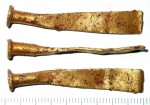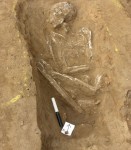 Museum of London archaeologists excavating the site of the future Waldorf Astoria hotel on the outskirts of the historic Syon Park Estate in west London have discovered a Roman settlement complete with road, burials and over 11,000 individual artifacts. This astonishing wealth of antiquity was found just a foot and a half (half a meter) under the surface 2 years ago, but is only being announced now.
Museum of London archaeologists excavating the site of the future Waldorf Astoria hotel on the outskirts of the historic Syon Park Estate in west London have discovered a Roman settlement complete with road, burials and over 11,000 individual artifacts. This astonishing wealth of antiquity was found just a foot and a half (half a meter) under the surface 2 years ago, but is only being announced now.
 Most of the artifacts found are fragments of pottery, but archaeologists also found 100 coins, a mean-looking cleaver, Roman jewelry like shale bangles and even parts of a late Bronze Age (1000-700 BC) gold bracelet. The skeletons are buried in an unusual way — in shore ditches with no grave goods — and since there are no specific cultural or date markers, they’re a bit of a mystery right now. They may predate the Romans.
Most of the artifacts found are fragments of pottery, but archaeologists also found 100 coins, a mean-looking cleaver, Roman jewelry like shale bangles and even parts of a late Bronze Age (1000-700 BC) gold bracelet. The skeletons are buried in an unusual way — in shore ditches with no grave goods — and since there are no specific cultural or date markers, they’re a bit of a mystery right now. They may predate the Romans.
Jo Lyon, a senior archaeologist at the [Museum of London], said: “We were extremely fortunate to discover such a comprehensive repertoire of Roman finds and features so close to the surface. They tell us a great deal about how the people of this village lived, worked and died.
“The archaeology at Syon Park has given us a valuable, rare insight into the daily life of an agricultural village on the outskirts of Londinium (London) that would have supplied the Roman city and provided shelter for travellers passing through. It helps us build a picture of the Roman landscape and shows how the busy metropolis of Londinium connected with the rest of Roman Britain.”
 Londinium was founded by the Romans around 49 A.D., 7 years or so after the 43 A.D. invasion of Britain. They built roads in and out and settlements radiated outwards around the roads. The Syon Park village was between the road and the Thames, a highly convenient location both for travel and for agriculture. Most Roman settlements were continuously built over. This one remained intact just under the surface despite its suburban London location thanks to its being preserved as parkland in the Syon estate.
Londinium was founded by the Romans around 49 A.D., 7 years or so after the 43 A.D. invasion of Britain. They built roads in and out and settlements radiated outwards around the roads. The Syon Park village was between the road and the Thames, a highly convenient location both for travel and for agriculture. Most Roman settlements were continuously built over. This one remained intact just under the surface despite its suburban London location thanks to its being preserved as parkland in the Syon estate.
Local legend has it that the area where they were found is just a few hundred yards away from where Julius Caesar crossed the Thames and defeated an alliance of British tribes under chieftain Cassivellaunus in 54 B.C.
The Duke of Northumberland, whose family has held residence at Syon Park for more than 400 years, said: “Syon Park has a rich and remarkable history. The Roman findings are an incredible addition to this legacy and emphasise Syon Park’s place as a prominent landmark in ancient British history.”
The Waldorf Astoria is scheduled to open early next year. Some of the artifacts will go on display in the luxury hotel.
[youtube=http://www.youtube.com/v/tzLrSZGrGhQ&w=430]
IIRC the Romans practiced cremation. Burial was considered to be barbaric.
Not all the time and not with everone. Inhumation went in and out of fashion, and some families, most famously the patrician Metelli and Cornelii, always buried their dead. By the second century A.D., burial was more popular than cremation in the empire, and not just among the Christians packing them into catacombs.